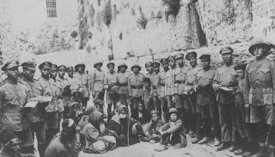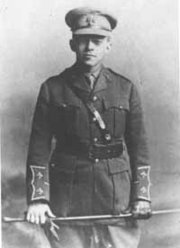Jewish Legion
|
|
This article is about the Jewish Legion, also known as the Zion Mule Corps of the British Army that fought in World War I against the Ottoman Empire. For other Jewish legions, see Jewish legion (disambiguation).
When Britain waged war against the Ottoman Turks, during World War I, Zionists around the world saw it as an opportunity to promote the idea of a Jewish National Homeland.
During December 1914, Zeev Jabotinsky and Joseph Trumpeldor raised the idea of the formation of a Jewish unit that would participate in the liberation of Palestine, and by the end of March 1915, 500 Jewish volunteers from among the Jews in Egypt (deported by the Turks) had started training.
Before the war ended, five battalions of Jewish volunteers were established for the British Army, the 38th through 42nd (Service) Battalions of the Royal Fusiliers. Together they were known as the Jewish Legion.
The British opposed the participation of Jewish volunteers on the Palestinian front and they were put to serve as a detachment for mule transport on another sector of the Turkish front. Trumpeldor formed the 650-strong Zion Mule Corps, of whom 562 were sent to the Gallipoli front where Trumpeldor led his troops with great distinction. Jabotinsky served as an officer, and advocated the idea of a Jewish Legion for the Palestinian front. Finally, in August 1917, the formation of a Jewish regiment was officially announced.
The unit was designated as the 38th Battalion of the Royal Fusiliers and included British volunteers, as well as members of the former Zion Mule Corps and a large number of Russian Jews. On April 1918, it was joined by the 39th Battalion, made up almost entirely of Jews who were resident in the United States and Canada.
In June 1918, the volunteers of the 38th Battalion fought for the liberation of Eretz Israel (Palestine) from Turkish rule some 20 miles north of Jerusalem.

In the fighting in the Jordan Valley, more than 20 Legionnaires were killed, wounded, or captured, the rest came down with malaria, and 30 of this group later died. The Legion then came under the command of Major General E.W.C. Chaytor.
1918_Private_BenGurion_volunteer_in_Jewish_Legion.jpg
The Legion's mission was to cross the Jordan River. Jabotinsky led the effort. Later, he was decorated and General Chaytor told the Jewish troops: "By forcing the Jordan fords, you helped in no small measure to win the great victory gained at Damascus."
Thousands of Palestinian Jews applied to join the Legion and in 1918, more than 1,000 were enlisted. 92 Turkish Jews who had been captured in the fighting earlier were also permitted to enlist. This group was organized as the 40th Battalion.
Almost all the members of the Jewish regiments were discharged immediately after the end of World War I in November 1918. Some of them returned to their respective countries, others settled in Palestine to realize their Zionist aspirations. In late 1919, the Jewish Legion was reduced to one battalion titled First Judeans, and awarded a distinctive cap badge, a menorah with the Hebrew word Kadima ("forward").
Reference
- The Jewish Legion at regiments.org (http://www.regiments.org/milhist/mideast/il-regts/JewLeg.htm), contains another image of the badge cap
- Jewish Role in WWI at palestinefacts.org (http://www.palestinefacts.org/pf_ww1_jewish_role.php)he:גדוד נהגי הפרדות



